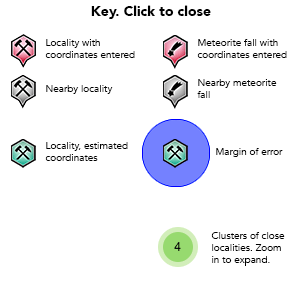Ruby Queen No. 7 Gold Mine (Rising Sun), Halls Creek Goldfield, Halls Creek Shire, Western Australia, Australiai
| Regional Level Types | |
|---|---|
| Ruby Queen No. 7 Gold Mine (Rising Sun) | Mine |
| Halls Creek Goldfield | Ore Field |
| Halls Creek Shire | Shire |
| Western Australia | State |
| Australia | Country |

| Latitude & Longitude (WGS84): | 18° 26' 28'' South , 127° 45' 28'' East |
|---|---|
| Latitude & Longitude (decimal): | -18.44114,127.75780 |
| GeoHash: | G#: qudz54yks |
| Locality type: | Mine |
| Köppen climate type: | BSh : Hot semi-arid (steppe) climate |
The Ruby Queen line of reef is found 8 kilometres south of Duncan Road (see Ruby Queen Mindat locality). Shortly after discovery around 1886, several leases were pegged named No. 1 to 7. No. 7 was also called the Rising Sun.
The mine produced 586 tonnes of ore for 15.2 kg of gold before 1897. The only information was found between 1888 to 1890. Mid 1888, the mine was taken over by a Mr. Taylor who almost immediately floated it in Melbourne for 120 000 pounds capital. The following year a battery had been erected and by 1890 it was closed due to a lack of water.
12 acres. Mine located to the north of the Ruby Queen Extended North mine, on the opposite side of a creek, and east of the Sunny Corner mine. The battery was near the creek, while the main workings were at the top of the hill. A shaft had been sunk to 60 feet, stoped either side. The reef dips west, with well defined sandstone and clay-slate walls, 1 to 3 feet wide, said to have contained rich specimen stone in the early days.
A central shaft and northern shafts were to the west and north, both down to 50 feet, all three shafts connected to each other at the 40 foot level. The mine crushed 550 tonnes of ore for 437 ounces of gold. The source states a lot of useless work had been conducted on the lease when inspected in 1891, and crushings had been kept private, so may have been more than officially listed.
Select Mineral List Type
Standard Detailed Strunz Dana Chemical ElementsCommodity List
This is a list of exploitable or exploited mineral commodities recorded at this locality.Mineral List
1 valid mineral.
Rock Types Recorded
Select Rock List Type
Alphabetical List Tree DiagramDetailed Mineral List:
| ⓘ 'Clay' Reference: Woodward, H.P. (1891) Report on the Goldfields of the Kimberley District. Colonial Government of Western Australia, Paper No. 18.
|
| ⓘ Gold Formula: Au Reference: Woodward, H.P. (1891) Report on the Goldfields of the Kimberley District. Colonial Government of Western Australia, Paper No. 18.
|
| ⓘ 'commodity:Gold' Formula: Au Reference: From USGS MRDS database |
| ⓘ 'Sandstone' Reference: Woodward, H.P. (1891) Report on the Goldfields of the Kimberley District. Colonial Government of Western Australia, Paper No. 18.
|
| ⓘ 'Slate' Reference: Woodward, H.P. (1891) Report on the Goldfields of the Kimberley District. Colonial Government of Western Australia, Paper No. 18.
|
List of minerals arranged by Strunz 10th Edition classification
| Group 1 - Elements | |||
|---|---|---|---|
| ⓘ | 'Gold' | 1.AA.05 | Au |
| Unclassified Minerals, Rocks, etc. | |||
| ⓘ | 'Clay' | - | |
| ⓘ | 'Sandstone' | - | |
| ⓘ | 'Slate' | - | |
List of minerals arranged by Dana 8th Edition classification
| Group 1 - NATIVE ELEMENTS AND ALLOYS | |||
|---|---|---|---|
| Metals, other than the Platinum Group | |||
| ⓘ | Gold | 1.1.1.1 | Au |
| Unclassified Minerals, Rocks, etc. | |||
| ⓘ | 'Clay' | - | |
| ⓘ | 'Sandstone' | - | |
| ⓘ | 'Slate' | - | |
Regional Geology
This geological map and associated information on rock units at or nearby to the coordinates given for this locality is based on relatively small scale geological maps provided by various national Geological Surveys. This does not necessarily represent the complete geology at this locality but it gives a background for the region in which it is found.
Click on geological units on the map for more information. Click here to view full-screen map on Macrostrat.org
| Paleoproterozoic 1600 - 2500 Ma ID: 3186269 | Paleoproterozoic sedimentary rocks Age: Proterozoic (1600 - 2500 Ma) Comments: Arunta Block Lithology: Sedimentary rocks Reference: Chorlton, L.B. Generalized geology of the world: bedrock domains and major faults in GIS format: a small-scale world geology map with an extended geological attribute database. doi: 10.4095/223767. Geological Survey of Canada, Open File 5529. [154] |
| Orosirian 1800 - 2050 Ma ID: 747683 | Olympio Formation Age: Orosirian (1800 - 2050 Ma) Stratigraphic Name: Olympio Formation Description: Monotonous sequence of weakly metamorphosed, thin- to medium-bedded mudstone, siltstone, and matrix-supported quartz wacke, greywacke and arkose. Thicker metamorphosed coarse-grained to pebbly, clast-supported quartz sandstone units are also present. Comments: feldspar- or lithic-rich arenite to rudite; sedimentary carbonate; synthesis of multiple published descriptions Lithology: Feldspar- or lithic-rich arenite to rudite; sedimentary carbonate Reference: Raymond, O.L., Liu, S., Gallagher, R., Zhang, W., Highet, L.M. Surface Geology of Australia 1:1 million scale dataset 2012 edition. Commonwealth of Australia (Geoscience Australia). [5] |
Data and map coding provided by Macrostrat.org, used under Creative Commons Attribution 4.0 License



